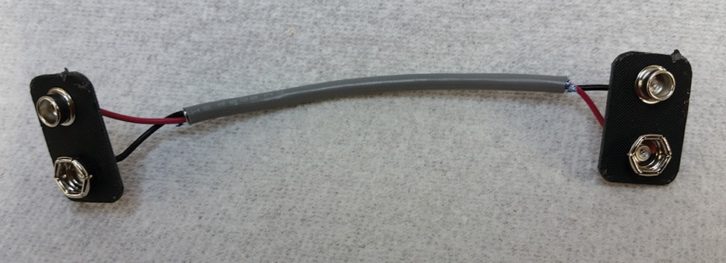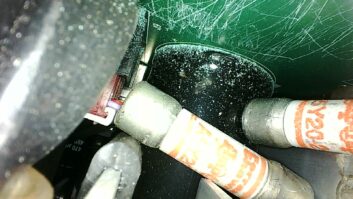Clay Freinwald, a principal in Clay Freinwald Technical Services, enjoyed reading “A Dead Battery Can Ruin Your Station’s Day” (Workbench, Nov. 13, 2019). Clay tells us that in his opinion, batteries are ticking time bombs waiting to attack their surroundings chemically. The losses and frustrations caused by this problem can be significant.
As for the BE transmitters with a 9 volt power set-point memory system, Clay is familiar with this approach; he said someone on a design team must have loved the idea, for it was used across a number of BE products. Not only did the designer place the battery right on the circuit board, they used a mechanical fastening system that Clay found frustrating. The battery was then hidden away, out of sight, behind a panel. The result, he feels, was a trap for an engineer who had no clue it was there.
Clay is not one merely to complain; he offers a solution to this problem. Pictured in Fig. 1 is a fix that Clay has deployed over the years. He constructed this “jumper” easily out of a couple of retired 9 volt batteries.

Peel back the metal case with needle-nose pliers or a pair of diagonal cutters (dykes) and remove the contact board. Observing the polarity, connect the two connector boards with a chunk of Belden 9451. Then plug the jumper into the socket on the printed circuit board. The other end of the jumper connects to the battery.
Clay’s design accomplishes a couple of things. First, it keeps the battery away from the circuit board. Second, you no longer have to deal with the frustrating battery clasp. If you construct one of these jumpers, as mentioned, be sure to watch the polarity as you solder the wires!
Further, in some cases, Clay has placed his battery assembly inside an empty plastic pill bottle; there is usually room in the BE rigs to hold this. Should the battery go bad or be forgotten, your loss is minimal; you can throw away the whole corroded thing.
Using “dead” 9V batteries to provide the contact board reduces the cost of this jumper assembly to nearly zero.
When I maintained these transmitters and other gear with “memory-keep-alive” batteries inside, I added a label on the front of the equipment labeled “BATTERY INSIDE,” and left space to mark when the battery was last changed.
* * *
Jay Melnick works for ColoRadio Communications Group. He has been following what has become a series of suggestions on keeping rodents out of your transmitter sites.
Jay offers a great resource for a variety of traps: YouTube! Particularly a channel named “Mousetrap Mondays.” The site has been around for a few years, and all kinds of traps for unwanted guests are tested. Some of the solutions are do-it-yourself.
* * *
Charles Cooper provides engineering services in West Africa, where they too have rodent issues at transmitter sites.
Chuck reminds us not to forget to add pieces of charcoal along the rodent “Super Highway,” better known as the intersection of vertical walls to the floor, where mice usually travel. Chuck has found the charcoal will repel the rodents — maybe the smell of impending barbecue?
To keep the charcoal in place, drop a couple chunks in the toe of a woman’s old nylon stocking and knot the end. The smell still permeates the room, but the stocking reduces the chance that bits of charcoal or dust will dirty your site.
* * *
Dan Slentz sent me a really neat link for engineers who are turned on with orderly wiring.
Especially in this day of audio over IP, you usually end up with a cabinet or rack full of cable spaghetti — Cat-6 Ethernet cables of differing lengths, with no easy way to lace them up to make the bundles look orderly.
Dan’s “find” is a product called the Patchbox Plus+ from Austrian company Patchbox. Its retractable cables provide the perfect length cable every time. Network cable installation is also faster; you’ve got to see the video of their Patchbox Speed Challenge and how quickly interconnect wiring is installed. The company offers a number of pictures showing “traditional wiring” versus Patchbox Plus+ wiring. You’ll be amazed.
Here’s the website: https://patchbox.com/patchbox-plus.
* * *
Set a goal — and maybe earn a pay raise — by getting certified by the Society of Broadcast Engineers in 2020.
Successful completion of any level of certification not only provides you with a professional certificate but also a letter to your boss from the SBE, complimenting you on your achievement. An ideal combination for a salary review! Remember, recertification credit is provided to engineers who share a tip published in Workbench. Thank you for sharing your tips and high-resolution photos by sending them to [email protected].
John Bisset has spent 50 years in the broadcasting industry and is still learning. He handles western U.S. radio sales for the Telos Alliance. He holds CPBE certification with the Society of Broadcast Engineers and is a past recipient of the SBE’s Educator of the Year Award.







